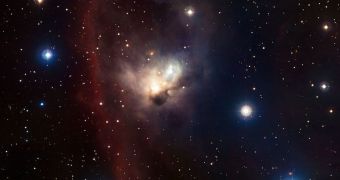Scientists at the European Southern Observatory (ESO) have just released a new image of a neglected corner of the Orion Constellation, which depicts the delicate and beautiful nebula NGC 1788. The space structure is an active stellar nursery, which is capable of producing many new stars. The amazing level of detail in the new photograph reveals the a wild and rugged “starscape,” in which stellar winds interact with gas to make the nebula glow, and also capable of further producing young blue stars.
The formation is relatively isolated from all the other stars the Orion Constellation is known for, but it is still subjected to winds and radiation coming in from all around. Their interactions have over millions of years made the stellar nursery take on a ghostly appearance, but have maintained it capable of housing sufficient gas clouds to continue manufacturing stars. For amateur astronomers out there, this subtle and little-known treasure in Orion can be found just a few degrees away from Orion's Belt, a region of the constellation that houses some of its brightest stars.
“NGC 1788 is a reflection nebula, whose gas and dust scatter the light coming from a small cluster of young stars in such a way that the tenuous glow forms a shape reminiscent of a gigantic bat spreading its wings. Very few of the stars belonging to the nebula are visible in this image, as most of them are obscured by the dusty cocoons surrounding them. The most prominent, named HD 293815, can be distinguished as the bright star in the upper part of the cloud, just above the center of the image and the pronounced dark lane of dust extending through the nebula,” experts at ESO say of the new photo.
The team adds that all of the stars in the nebula are very young, with most of them being less than a million years old. While this may seem like a long time for us, it's only the blink of an eye in astronomical and geological terms. For comparison, our own yellow dwarf, the Sun, is already at least 4.5 billion years old, and is scheduled to reach as much as 10 billion years of age before finally swelling into a red giant, and then dying off as a white dwarf. The new image of NGC 1788 was collected using the ESO MPG/ESO 2.2-meter telescope, which is located in Chile, at the La Silla Observatory. The Wide Field Imager instrument is responsible for all the fine details.

 14 DAY TRIAL //
14 DAY TRIAL //